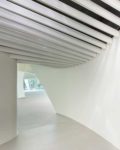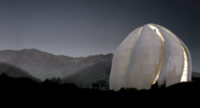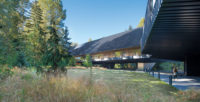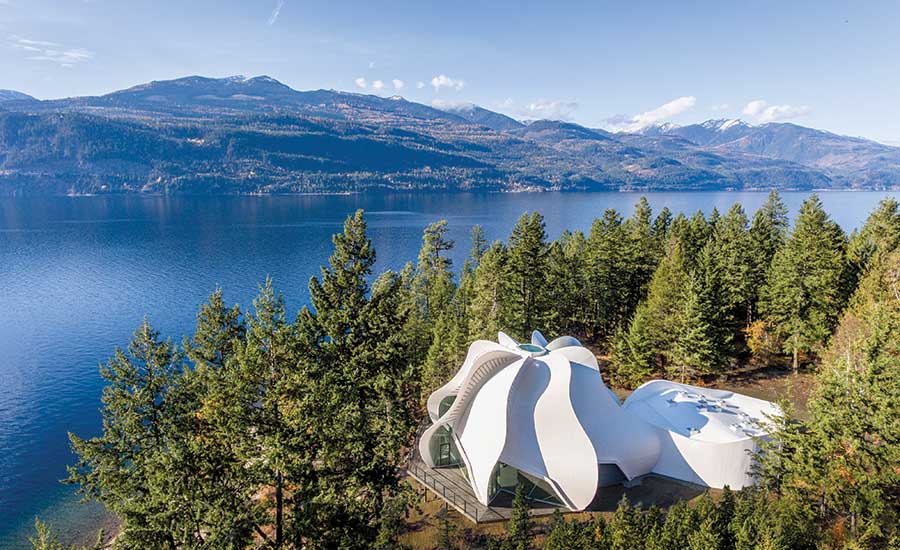Temple of Light by Patkau Architects
Kootenay, British Columbia

Beside Kootenay Lake, the building’s curving lines relate to its landscape.
Photo © Dan Seguin

Beside Kootenay Lake, the building’s curving lines relate to its landscape.
Photo © Amy Allcock

Prefabricated panels are glazed along their base to provide expansive views.
Photo © James Dow

From the foyer, an oblique entrance to the sanctuary intensifies the arrival experience.
Photo © James Dow

The light and fluid architecture of the main volume, with an acoustic chandelier beneath a central oculus, supports performances as well as contemplation.
Photo © Amy Allcock

One of the temple’s eight doors, in the offset between two petals, is glimpsed on the way to the main entrance. The compound curves are constructed entirely of straight members.
Photo © James Dow

Image courtesy Patkau Architects

Image courtesy Patkau Architects

Image courtesy Patkau Architects

Image courtesy Patkau Architects

Image courtesy Patkau Architects











Architects & Firms
From the air, the ridges of Canada’s Kootenay Mountains—north of Washington, Idaho, and Montana—unfold in immaculate white crests, their slopes descending in scoops and scallops to the trees. On the ground, a solitary highway winds around the mountains’ shoulders, along a lake, beside a river. Eagles arch their wings against the sky. By the time you reach the Temple of Light, a sanctuary designed by Patkau Architects for Yasodhara Ashram, a yoga retreat and study center on the shore of Kootenay Lake, you recognize the lines of the landscape abstracted in the building’s curving white form.
Additional Content:
Jump to credits & specifications
“The temple is an invitation to the light,” says John Patkau, cofounder of the Vancouver firm, “both physically, through its strong relationship with the sky and wilderness beyond, and metaphysically, through its invocation of wonder.” Completed in 2017, for a cost of $2.6 million, the 3,500-square-foot structure (including entry and support spaces as well as the main volume) sits on a high bank beside the lake, on the site of an earlier temple destroyed by fire. The surviving foundation, reused for the new building, and community memories of the eight-sided domed structure that was lost, provided a starting point for the scheme, according to Patkau. The firm’s experimental work in the morphology of materials–such as its plywood Skating Shelters (Winnipeg, 2011)—further informed the design.
The new temple consists of an elaborated dome comprising eight curving petals, pinwheel in plan, with eight doors intended to welcome people from all spiritual paths, and suffused with light throughout. The form also evokes the unfolding lotus flower of yogic iconography.
Although the formal achievement is impressive, the human experience generated by the temple’s spatial composition is its real triumph. Approached along a footpath that dips and climbs from the ashram’s main entrance, with lake and mountain glimpses hinting at wider views from within, the temple is a mystery, seen only partially and in passing before a wall curving around to the entry conceals it again. An overscaled portal angles down toward the doors; the foyer’s slatted ceiling lifts in welcome, then swoops to intensify the oblique entrance to the main space.
Not petals so much as wings: inside the temple, the geometry soars. Spectacular lake and mountain views open out from the volume’s base. Careful attention to acoustics has given the space a lovely resonance. Light from glazed or electrically illuminated offsets between the panels slips across smooth inner surfaces, and shadow-brushed heights generate a sense of magnificence. At the top, an oculus collects the sanctuary around a bright center. The result is ethereal, dynamic, and profound.
Supporting the architecture’s spiritual qualities, the temple benefits technically from a series of explorations that Patkau has been conducting into how the properties of conventional building materials (such as wood) can inform design. Each of the temple’s petals constitutes a ruled surface. To visualize: imagine twisting the side-rails of a ladder while leaving the rungs attached; even though the helix-like surface that the rungs define would be curved, every point on the surface would sit on a straight line between the rails.
This principle allowed the compound curves of the Temple of Light to be prefabricated using straight pieces of lumber, then sheathed in plywood to form a structural shell—complete with insulation, air and vapor barrier, and the rest—and shipped in segments to the ashram. (Spearhead, an architectural timber and steel fabricator, is serendipitously located across the lake.) On-site, the pieces were fastened to a compression-ring-cinched structure of glulam primary arches supporting steel secondary arches. Triple glazing supplements the panels where their bases are cut away for views, and the whole is sealed on the exterior with a liquid polymethyl-methacrylate (PMMA) membrane. On the interior, painted drywall and plaster finish the compound curved surfaces.
“The complex play of light and sound on the temple’s fluid surfaces belies the modesty and relative simplicity of the ruled structure concealed within,” says Patkau. “This ruled structure transforms otherwise conventional, straight timber elements into subtly curving space, providing the community with opportunities for contemplation and celebration that are directly enhanced by the temple’s flowing form.”
Since the Temple of Light opened, a little over a year ago, it has hosted ceremonies and performances as well as reflection and meditation. During gatherings, “the fullness of it is beautiful,” says Swami Lalitananda, Yasodhara’s president. “It feels as though it can hold all who come.” When the temple is empty, she says, “sometimes I just sit here and look at those lines.”
CreditsArchitect: Patkau Architects—John Patkau, Patrica Patkau, principals; Luke Stern, project leader; Mike Green, John Lacy, Tom Schroeder, Peter Suter, project
Engineering: Equilibrium (structural); Integral Group (mechanical, electrical)
Consultants: Spearhead (timber); TDH Building Science (envelope); Render Light and Planning (lighting); RWDI (acoustics)
General contractor: Alfred Horie Construction |
SpecificationsExterior cladding Soprema (PMMA); Durock (stucco)
Roofing Soprema (PMMA); Sika (PVC)
Glazing Raico
Doors Aluminex (entrance); Raico (metal)
Interior finishes Sonex (acoustic baffles); Forbo (floor tile); Colin Campbell (carpet)
Lighting WAC (chandelier); Clarus, Amerlux, Lightheaded, Lumenwerx, Bega, Solatube (interior ambient)
Bathroom fixtures Toto, American Standard
Photovoltaic system Bluesun Solar
Geothermal heat pump Geostar |

















